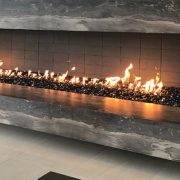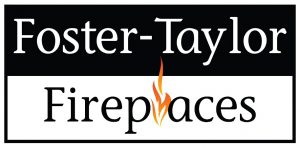When selecting a fireplace, stove, or insert for your home, one crucial factor to consider is the venting system. While some hearth products, like electric or vent-free appliances, do not require venting, most fireplaces, stoves, and inserts—whether fueled by gas, wood, or pellets—depend on venting to circulate fresh air and remove harmful combustion byproducts from your home.
Choosing the correct venting method is essential for both safety and efficiency. With multiple venting options available, it can be challenging to determine which one is best suited for your home. Understanding the different venting methods will help you make an informed decision and simplify the process of selecting, buying, and installing your hearth product.
The Importance of Proper Venting
“Fireplaces require proper venting because fire needs oxygen to burn and produces carbon dioxide and other byproducts that need to be expelled safely,” explains Julie Milum, vice president at Hearth & Home Technologies. Proper venting ensures that your home remains safe and your fireplace operates efficiently.
There are several ways to route venting for fireplaces, stoves, and inserts, and the direction and logistics often depend on the type of hearth product and the fuel it burns. Below, we explore the different venting technologies and what experts recommend when selecting the right fireplace for your home.
Venting a Gas Fireplace
Gas fireplaces are popular for home heating, with natural gas being the most common fuel source. Gas fireplaces can be vented in one of three ways:
- Direct Vent Technology: This sealed combustion system draws air from outside the home and expels all combustion byproducts outdoors. It is the most common and efficient venting method for gas fireplaces, providing flexibility in installation without requiring an existing chimney.
- B-Vent (Natural Vent) Technology: This system draws air from inside the room into the combustion chamber and vents exhaust through the roof. While simpler to install in some cases, it is less efficient and can result in heat loss.
- Vent-Free (Ventless) Technology: These units burn at a high temperature to eliminate combustion byproducts without the need for venting. Although highly efficient, they require large, well-ventilated rooms and are not allowed in some regions due to concerns about indoor air quality.
Direct Vent Fireplaces: The Preferred Option
Direct vent fireplaces have become the most popular choice for homeowners due to their efficiency, safety, and flexibility. They do not require a chimney, making them easy to install in various locations throughout the home.
How It Works:
A direct vent fireplace draws fresh air from outside and expels exhaust through a double-flue system. The inner flue carries exhaust out of the home, while the outer flue brings in fresh air for combustion. This system keeps the fireplace sealed from the indoor environment, ensuring that no indoor air is used or contaminated.
Venting Options:
- Horizontal Venting: Ideal for installations on exterior walls, this method involves running the vent pipe directly through the wall. It is a cost-effective and straightforward solution.
- Vertical Venting: Necessary for interior wall installations or when an existing chimney is available, this method involves venting through the roof. Although more labor-intensive, it is often required for certain home layouts.
Power Venting:
In cases where natural airflow is insufficient, a power venting system can be added to boost efficiency. This fan-powered accessory helps move air through the venting system and allows for more complex venting configurations, such as venting downwards or around obstacles.
B-Vent Fireplaces: A Traditional Option
B-vent fireplaces, also known as natural vent fireplaces, use indoor air for combustion and vent exhaust through the roof. While they are less efficient than direct vent systems, they can be an option for homes with existing chimneys or where simpler installation is preferred.
How It Works:
B-vent fireplaces rely on the natural buoyancy of hot air to expel combustion byproducts through a chimney. A double-wall pipe is used, with the outer layer acting as a heat insulator.
Installation Considerations:
B-vent fireplaces require vertical venting through the roof, which can limit installation flexibility and increase labor costs. They are less efficient than direct vent systems, as some heat is lost through the chimney.
Vent-Free Fireplaces: Efficient, But with Limitations
Vent-free fireplaces do not require any venting, making them incredibly efficient and easy to install. However, they must be used in well-ventilated rooms, and they are not permitted in some regions due to concerns about indoor air quality.
How It Works:
A vent-free fireplace draws room air for combustion and burns at a high temperature to minimize combustion byproducts. The resulting heat is released back into the room without any venting required.
Pros and Cons:
While vent-free fireplaces are highly efficient and cost-effective, they produce humidity in the room and require careful placement and regular maintenance to ensure safety.
Wood-Burning Fireplace Venting
Wood-burning fireplaces and stoves require vertical venting through the roof. This involves constructing a chimney and installing a flue to safely expel smoke and combustion byproducts.
Venting Options:
- Wood-Burning Stoves: These require a Class A chimney for venting. The stove is connected to the chimney via a ventilation pipe that draws in fresh air and expels smoke.
- Wood-Burning Inserts: These are installed in existing fireplaces and use a stainless steel chimney liner for venting.
Pellet Stove Venting
Pellet stoves, which burn compressed wood or biomass, can be vented through an existing chimney or horizontally through a side wall. They offer flexibility in installation and are a low-maintenance, eco-friendly heating option.
How It Works:
Pellet stoves use a pressurized hybrid system with a stainless-steel inner wall and gaskets to ensure a tight seal. Venting can be done through a side wall or an existing chimney, making them versatile and efficient.
Choosing the Right Venting System for Your Home
Selecting the right fireplace or stove for your home involves considering both your heating needs and the available venting options. Whether you prioritize efficiency, flexibility, or aesthetics, understanding the different venting methods will help you make an informed decision and ensure that your hearth product meets your expectations.
Consider These Factors:
- Placement: Decide where you want to install your fireplace, considering both exterior and interior walls and the venting requirements for each option.
- Purpose: Determine whether you need your fireplace for heating, ambiance, or both, and choose a venting system that aligns with your goals.
- Installation Costs: Factor in the cost of installation, including any additional labor or materials required for venting.
With the right venting system in place, your fireplace will provide warmth, comfort, and enjoyment for years to come. Consult with a hearth expert to explore your options and find the perfect solution for your home.
